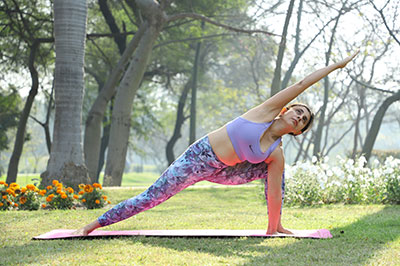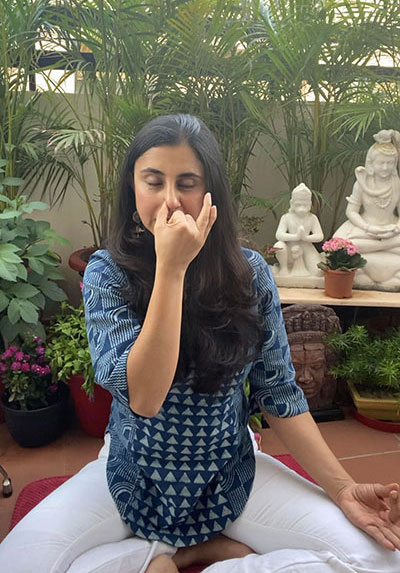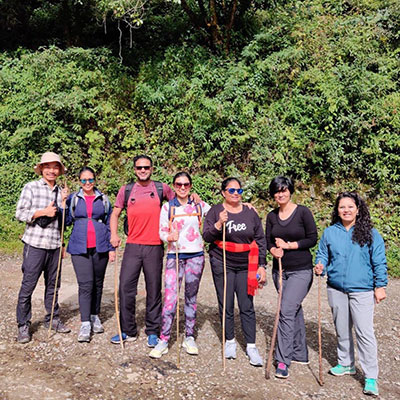By Shibani Sahni
Yoga is an Indian spiritual and ascetic discipline, a part of which includes breath control, meditation, concentration, focus, and the adoption of specific bodily asanas or postures. Yoga helps us come closer to understanding our true selves; and blends in beautifully with our proactive approach of self-discovery. Yoga is an excellent tool to understand the self, it is a meditation that brings us closer to who we really are.
The subtle approach of YOGA works at a subliminal level, positively impacting our mind, body, and energy levels. Raising our inner life force or life energy, also known as Prana.
In ancient times, yoga in India was widely practiced primarily to awaken to the true self, and transcend one’s lower nature to attain a state of enlightenment. You can say – ones personal yoga practice was a journey to explore an authentic sense of absolute truth, unconditional happiness, and universal awareness, within the self.
Yoga even today, if practiced like it is meant to – mindfully as a meditation, and as an art form, can be extremely effective in tapping into our true nature. I refer to it as, a remarkably significant, inward journey towards self-realization.
Swami Vishnudevananda, the founder of the Sivananda Yoga Ashrams and Centers, established 5 prominent aspects of YOGA. These were based on the teachings of Swami Sivananda. Given below is my personal interpretation of these five aspects:
Fundamental benefits
 Proper physical exercises, or yoga asanas in Sanskrit, has a positive effect on all parts of our body. Similar to the function of oil in an engine, the asanas enhance the flexibility of the joints, muscles, tendons, and ligaments; and stimulate circulation.
Proper physical exercises, or yoga asanas in Sanskrit, has a positive effect on all parts of our body. Similar to the function of oil in an engine, the asanas enhance the flexibility of the joints, muscles, tendons, and ligaments; and stimulate circulation.
Yoga asanas have a rejuvenating and revitalizing effect on the whole organism and are thus incomparable to any other system or form of exercise. When performed slowly, coordinated with our breath, with complete awareness - the asanas give us a sense of physical well-being. At the same time, our asana practice is a meditation enhancing concentration and focus. As we mindfully maintain our attention and awareness on our breath and on the posture, during our yoga practice, we unite the mind and body by bringing them together for the duration of the posture. The outcome of this meditative practice is a strong and flexible body, an alert mind, and a resilient immune system!
Importance of the Spine
Yoga asanas are primarily focused on the health of the spine. The spine is the base of the central nervous system, the body’s communication system. The spine is a direct extension of the brain, so a healthy, straight spine promotes the health of the entire body. A flexible spine is a strong spine; and a strong spine is a strong immune system.
Keeping the spine strong and flexible through our yoga practice, stimulates blood circulation, and ensures an adequate supply of energy and oxygen to the nerves. Keeping the body healthy, fit, and flexible. Given the significant role of the spine in our body, it can be referred to, as the energy center or powerhouse of our entire existence.
Goal: Control over the mind
Asanas stimulate the seven energy centers of the body. When these points are activated, the flow of prana (life force or life energy) increases. Performing the asanas helps massage all our internal organs and boosts organ functioning.
Together, the yoga asanas along with deep breathing, relaxation, and concentration; help us develop control over the mind. The mind – by nature is restless and always following sense impulses. Through our dedicated and disciplined, daily yoga practice, we direct the mind inwards, withdrawing attention from the external world. In other words, through yoga we are able to take control over our own mind, by taking our awareness inwards.
 Breathing Circulates Energy
Breathing Circulates Energy
Proper breathing connects the body to its battery, the solar plexus, which is an enormous reservoir of energy. The breathing techniques of pranayama set this energy in motion and revitalize both, the body and mind. By consciously regulating our breath, we are able to store more prana (life force or life energy) and draw on these energy reserves in our daily life.
Learning to Breathe
Most people use only a small portion of their lung capacity when breathing. They breathe into the upper chest with hunched shoulders, leading to a lack of oxygen and tension in the upper back and the neck. Most people practice short and shallow breathing, and this leads to low oxygen supply to the body, thus causing many lifestyle-related ailments like – respiratory, cardiac, and digestive ailments, to name a few.
Long, Deep and Conscious abdominal breathing is an effective way to conquer stress, anxiety, and depression. It is also an ideal way to keep all our organs and systems at optimal functioning, given the adequate oxygen supply to the blood. A person who breaths long and deep has high pranic levels (prana) in the body, and always radiates strength and vitality.
The Secret of Healing
By controlling prana we gain control over the mind. Many diseases can be nipped in the bud simply by regulating our prana or energy levels: That’s the secret of healing. Through deep breathing / Pranayama we are able to calm the body and the mind, as we impact the Nervous System directly. We are able to increase lung capacity, balance our blood pressure, maintain great cardiac health, and improve memory, concentration and focus. Thus making our life so much more energetic, productive and constructive – leading to inner peace and happiness!
Activating the Parasympathetic Nervous System
 The Autonomic Nervous System (ANS) in our body is responsible for regulating the body's unconscious and involuntary actions. One part of the ANS is the Parasympathetic Nervous System (PNS), which is responsible for the activities that occur when the body is at rest. Some of these activities are – urination, tear generation, heart rate, blood flow, digestion, salivation, sexual arousal, defecation and many more. With our pranayama practice we activate the PNS, thus enhancing various essential bodily functions that support, restore and cleanse the body.
The Autonomic Nervous System (ANS) in our body is responsible for regulating the body's unconscious and involuntary actions. One part of the ANS is the Parasympathetic Nervous System (PNS), which is responsible for the activities that occur when the body is at rest. Some of these activities are – urination, tear generation, heart rate, blood flow, digestion, salivation, sexual arousal, defecation and many more. With our pranayama practice we activate the PNS, thus enhancing various essential bodily functions that support, restore and cleanse the body.
The actions of the PNS are complementary to that of the Sympathetic Nervous System, which is another part of the ANS and is known to stimulate activities associated with the ‘fight-or-flight response. So, with an active PNS the body stays far more calm and rested, functioning at its optimal level.
 Recharge our energies
Recharge our energies
Proper relaxation is an excellent cooling system, comparable to that of an automobile. It’s the most natural way of re-energising the body. Relaxation is extremely important because the body and mind cannot perform well under constant ongoing activity. After any asana session, it is vital for the body and mind to relax for a few minutes in savasana or corpse posture.
To control and balance our body and mind, we have to use the body’s energy very efficiently. That is the main motivation for learning how to relax.
Relaxation is not always easy
In our modern world, many people find it difficult to relax or to conserve their energy. By keeping our muscles in a constant state of readiness, we expend a lot more energy than we would if we used only those muscles needed for the job at hand. Unnecessary physical and mental tension uses up great amounts of energy. Even in periods of so-called rest, we sometimes waste a huge amount of our vital energy.
Have you ever returned from your holiday feeling exhausted? Or have you woken up from your sleep feeling tired? It can happen, despite the fact that our body actually produces a surplus of energy each day, enough to last us for the next day. We at times expend this energy without any control. The reasons that we are unable to retain this energy, are - negative emotions like anger, fear, stress, worry, anxiety, depression, obsession, being pessimistic, irritability, and restlessness, to mention a few. These can deplete our energy reserves in just a few minutes. It can also negatively impact the quality of our sleep.
Perfect relaxation with yoga
Our yoga practice of relaxation replenishes the energy stores of the body. That is why we seldom feel drained or exhausted after a yoga class. Instead, we feel charged, energized, relaxed, with lots of positive energy. At the end of our yoga class ‘deep relaxation’ is always a must, where we completely let go, lose all control of our body and mind; and simply melt into the ground under us. We relax all our muscles, our ligaments, tendons, and all our organs.
In this state of relaxation, only a very small amount of life energy (prana) is used, just enough to maintain vital metabolic activities. The rest of the energy is stored. This deep relaxation includes three levels: physical, mental and spiritual relaxation. Complete or perfect relaxation is possible only when all three levels are involved. So, a few minutes of yogic relaxation (5-10 minutes) can recharge us more effectively – and give us much more inner peace – than several hours of restless sleep.
 Eat to live
Eat to live
A yoga practitioner chooses food products that have the most positive effects on the body and mind and the least negative effects on our environment. Most conscious yoga practitioners eat plants based diets that get their nutrients directly from the sun, the energy source for all life on our planet.
Healthy and well balanced
A yogic diet is lacto-vegetarian and consists mainly of grains, pulses, fruits, vegetables, nuts, seeds, plants, and dairy products. A vegetarian diet is wholesome, easy to digest and supplies the body with a maximum amount of nutrients and energy. In general, we should select food items that are as fresh and natural as possible. As the food, we eat impacts the functioning of our brain.
Careful preparation of the food is essential to retain a maximum amount of nutrients. Long storage, refinement, too much refrigeration, or overcooking destroys many vital components of our food.
The mind eats too!
We literally are what we eat. Most people are unaware that the food we eat forms the substance of our mind as well – influencing it in a very subtle way. Some foods like fruits, nuts, vegetables, leafy greens, grains, legumes, sprouts are excellent for the body and the mind. Consuming excessive meat products is known to stiffen the joints, and brings about a sense of heaviness and lethargy in the body. Thus, a yogic diet ideally consists of pure food products and helps us keep, both, the body and mind, light, fresh, healthy and fit.
 Peace of mind
Peace of mind
Positive thinking and meditation are key elements to a peaceful existence. Meditation is the method used to calm, relax and focus the mind. Regular practice promotes not only mental equanimity but also physical and spiritual well-being. To meditate, we need to practice concentration and positive thinking. A mind full of negative thoughts and feelings is hard to calm down. So thinking positively, and being appreciative of our life, is the way to go. If we adopt an ‘attitude of gratitude’ to always look at life as a gift, and constantly live with joy, hope, and a persevering spirit; we almost certainly will have a far more peaceful existence on Earth.
Union with the Supreme Self
 By controlling the movements of the mind, we can eliminate negative thought patterns and reach the meditative super-conscious state (Samadhi). Samadhi is the blissful union with the Supreme Self and leads us to direct, intuitive experiences of the infinite. It is a deep spiritual experience that cannot be put into words or even grasped by the mind. In Samadhi, the senses, the mind and the intellect cease to function. The consciousness expands, going beyond time, space and causality. One realizes the divine presence pervading all life forms and experiences profound peace and joy - a feeling of oneness with the universe!
By controlling the movements of the mind, we can eliminate negative thought patterns and reach the meditative super-conscious state (Samadhi). Samadhi is the blissful union with the Supreme Self and leads us to direct, intuitive experiences of the infinite. It is a deep spiritual experience that cannot be put into words or even grasped by the mind. In Samadhi, the senses, the mind and the intellect cease to function. The consciousness expands, going beyond time, space and causality. One realizes the divine presence pervading all life forms and experiences profound peace and joy - a feeling of oneness with the universe!
In conclusion we can say, a consistent, disciplined, and committed yoga practice, works at our subconscious level, uncompromisingly assisting us in leading an expansive, genuinely joyful, self-reliant life. A practice that helps us ‘polish our lives’, leaning more towards the positive. Enabling us to create a lifestyle that is deeply rooted in awareness, realization and a healthy way of existence. Making us realize that health is wealth, and YOGA truly shows us the way, to lead a life of deep physical, mental and emotional fulfillment!